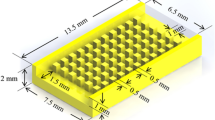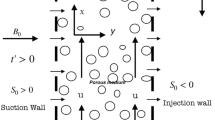Abstract
The present article reports on heat transfer characteristics associated with multiple laminar impinging air jet cooling a hot flat plat at different orientations. The work aims to study the interactions of the effects of cross flow, buoyancy induced flow, orientation of the hot surface with respect to gravity, Reynolds numbers and Rayleigh numbers on heat transfer characteristics. Experiments have been carried out for different values of jet Reynolds number, Rayleigh number and cross flow strength and at different orientations of the air jet with respect to the target hot plate. In general, the effective cooling of the plate has been observed to be increased with increasing Reynolds number and Rayleigh number. The results concluded that the hot surface orientation is important for optimum performance in practical applications. It was found that for Re ≥ 400 and Ra ≥ 10,000 (these ranges give 0.0142 ≤ Ri ≤ 1.59 the Nusselt number is independent on the hot surface orientation. However, for Re ≤ 300 and Ra ≥ 100,000 (these ranges give 1.59 ≤ Ri ≤ 42.85): (i) the Nusselt number for horizontal orientation with hot surface facing down is less that that of vertical orientation and that of horizontal orientation with hot surface facing up, and (ii) the Nusselt number of vertical orientation is approximately the same as that of horizontal orientation with hot surface facing up. For all surfaces orientations and for the entire ranges of Re and Ra, it was found that increasing the cross flow strength decreases the effective cooling of the surface.










Similar content being viewed by others
Abbreviations
- A :
-
Area of the hot target surface, m2
- A j :
-
Area of j the enclosure side wall, m2
- B :
-
Slot width, m
- F :
-
View factor
- G :
-
Irradiations, W/m2
- Gr :
-
Grashof number
- g :
-
Gravity acceleration, m/s2
- H :
-
Separation distance, m
- h :
-
Average heat transfer coefficient, W/m2 K
- I :
-
Electric current, Amp.
- J :
-
Radiosity, W/m2
- k a :
-
Thermal conductivity of air, W/m K
- k g :
-
Thermal conductivity of fiberglass, W/m K
- k w :
-
Thermal conductivity of plexigalss enclosure wall, W/m K
- Nu :
-
Average Nusselt number
- Pr :
-
Prandtl number
- q :
-
Convection heat transfer rate, W
- q c :
-
Conduction heat transfer rate, W
- q r :
-
Radiation heat transfer rate, W
- Ra :
-
Rayleigh number
- Re :
-
Air Reynolds number
- Ri :
-
Richardson number
- T H :
-
Hot surface temperature, K
- T j :
-
Jet inlet temperature, K
- T w :
-
Wall surface temperature, K
- t g :
-
Thickness of fiberglass insulation, m
- t w :
-
Thickness of plexiglass wall, m
- V :
-
Voltage input, volt
- Vj :
-
Jet exit velocity, m/s
- α :
-
Thermal diffusivity, m2/s
- β :
-
Coefficient of volumetric expansion, 1/K
- ε :
-
Emissivity, dimensionless
- v :
-
Kinematic viscosity, m2/s
- ρ :
-
Density, kg/m3
- σ :
-
Stefan–Boltzmann constant, W/m2 K4
References
Sezai I, Aldabbagh LBY (2003) The effect of jet-to-jet spacing on the cooling performance of impinging jet arrays. In: Proceedings of 31CCHMT, 3rd international conference on computational heat and mass transfer, Banff, Canada 26–30
Sezai I, Aldabbagh LBY (2004) A three dimensional numerical investigation of flow and heat transfer characteristics of inline jet arrays. Numr Heat Transfer 45:271–288
Kelso RM, Smith AJ (1995) Horseshow vortex systems resulting from the interaction between a laminar boundary layer and a transfer jet. Phys Fluids 7:153–158
Fric TF, Rosshko A (1994) Vortical Structure of the near field of the transverse jet. J Fluid Mech 1–47
Kelso RM, Lim TT, Perry AE (1996) An experimental study of round jets in cross-flow. J Fluid Mech 306:111–114
Barata JMM (1996) Fountain flows produced by multiple impingement jets in a cross-flow. AAIA J 34(12):2523–2530
Kim SW, Benson TJ (1993) Fluid flow of a row of jets in cross flow. A numerical study. AIAA J 31(5):806–811
Aldabbagh LBY, Mohamed AA (2006) Effect of jet to plate spacing in laminar array jets impinging. Heat Mass Transfer 43(3):265–273
Goldstein RJ, Behbahani AI (1982) Impingement of a circular jet with and without cross flow. Int J Heat and Mass Transfer 25(10):1377–1382
Al-Sanea S (1992) A numerical study of the flow and heat transfer characteristics of an impinging laminar slot jet including cross flow effect. Int J Heat Mass Transfer 35(10):2502–2513
Metzger DE, Florshuetz LW, Takeuchi DI, Bhee RD, Berry RA (1979) Heat transfer characteristics for inline and staggered arrays of circular jets with cross-flow of spent air. J Heat Transfer 101:526–531
Florshuetz LW, Berry RA, Metzger DE (1980) Periodic streamwise variations of heat transfer coefficients for inline and staggered arrays of circular jets with cross flow of spent air. ASME J Heat Transfer 102:132–137
Yoon PH, Rhee DH, Cho HH (2000) Effects of arrays of impinging jets with cross flow on heat/mass transfer. KEME J B 4(2):195–203
Kanokjaruvijit K, Martinez-boats RF (2005) Jet impingement on a dimpled surface with different cross flow schemes. Int J Heat Mass Transfer 48:161–170
Yang YT, Wang YX (2005) Three-dimensional numerical simulation of an inclined jet with cross-flow. Int J Heat Mass Transfer 48:4019–4027
Aldabbagh LBY, Sezai I, Mohamad AA (2003) Three dimensional investigation of a laminar impinging square jet interaction with cross flow. J Heat Transfer ASME 125:243–249
Rady M, Arquis E (2006) Heat transfer enhancement of multiple impinging slot jets with symmetric exhaust ports and confined surface protrusions. Appl Therm Eng 26:1310–1319
Satyanarayana S, Jaluria Y (1982) A study of laminar buoyancy jets discharged at an inclination to the vertical buoyancy force. Int J Heat Mass Transfer 25:1569–1577
Yan TD, Liburdy JA, Wg T (1988) Buoyancy effects on laminar impingining jets. Int J Heat Mass Transfer 31:2137–2145
Sahoo D, Sharif MAR (2004) Numerical modeling of slot-jet impingement cooling of a constant heat flux surface confined by a parallel wall. Int J Thermal Sci 43:877–887
Rady MA (2000) Buoyancy effects on the flow and heat transfer characteristics of an impinging semi-confined slot jet. Int J Trans Phenomena 2:113–126
Incropera FP, DeWitt DP (1995) Introduction to heat transfer. Wiley, New York
Suryanarayana NV (1995) Engineering heat transfer. West Publishing Company, New York
Holman JP, Gajda WJ (1989) Experimental method for engineers. McGraw Hill, New York
Author information
Authors and Affiliations
Corresponding author
Rights and permissions
About this article
Cite this article
Nada, S.A. Buoyancy and cross flow effects on heat transfer of multiple impinging slot air jets cooling a flat plate at different orientations. Heat Mass Transfer 45, 1083–1097 (2009). https://doi.org/10.1007/s00231-009-0480-2
Received:
Accepted:
Published:
Issue Date:
DOI: https://doi.org/10.1007/s00231-009-0480-2




